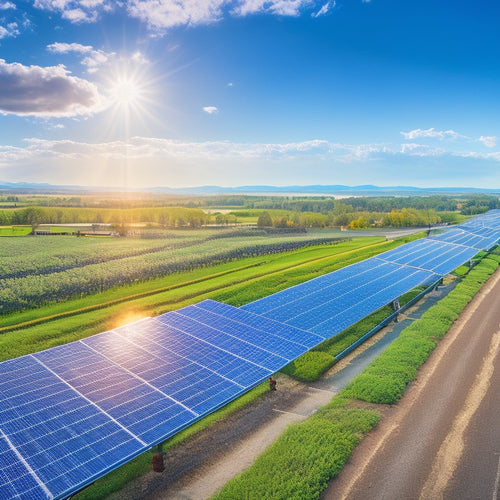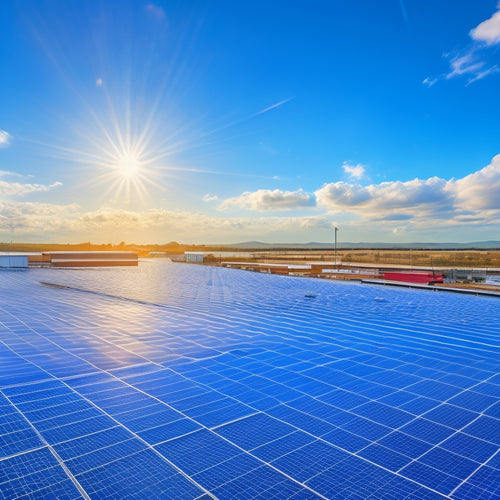
Must-Have Solar Installation Equipment for Efficiency
Share
To achieve peak solar energy efficiency, you'll need key installation equipment. Start with an energy needs assessment to size your solar system correctly. Choose high-efficiency solar panels—monocrystalline models excel in limited space. Invest in quality inverters, like microinverters or power optimizers, for better performance. Incorporate durable materials that withstand harsh conditions to enhance longevity. Don't forget about efficient battery systems, as they play a critical role in energy storage. By focusing on these components, you can maximize your investment and minimize energy costs, setting the stage to uncover further innovative strategies to amplify your solar efficiency.
At a Glance
- Conduct an energy needs assessment to determine the ideal size of your solar system for maximum efficiency.
- Invest in high-efficiency solar panels, such as monocrystalline, for improved energy production in limited spaces.
- Choose the right inverter type, such as microinverters, to enhance energy output, especially in shaded areas.
- Utilize durable materials like anodized aluminum and tempered glass to ensure longevity and performance of the solar installation.
- Implement regular maintenance practices to prolong the lifespan and maintain the efficiency of solar equipment.
Cost-Effective Energy Solution
When you consider solar installation, you'll find significant long-term savings potential that can drastically reduce your energy bills.
By evaluating your energy needs, you can determine the ideal system size that aligns with your usage patterns.
Additionally, many government incentives are available to offset the initial investment, making solar an even more attractive option.
Long-Term Savings Potential
Often overlooked in discussions about solar installation equipment is the substantial long-term savings potential it offers as a cost-effective energy solution. By investing in quality solar equipment and adopting proper installation techniques, you can greatly reduce your energy bills over time. Additionally, implementing effective maintenance practices guarantees your system operates at peak efficiency, maximizing your return on investment.
Here's a breakdown of potential savings over the years:
| Year | Estimated Savings | Cumulative Savings |
|---|---|---|
| 1 | $1,000 | $1,000 |
| 2 | $1,200 | $2,200 |
| 3 | $1,400 | $3,600 |
| 4 | $1,600 | $5,200 |
| 5 | $1,800 | $7,000 |
As you can see, the savings compound annually, making solar installation not just a choice for energy independence but also a smart financial decision. By prioritizing quality equipment and following recommended installation techniques and maintenance practices, you'll enjoy a sustainable, cost-effective energy solution that enhances your freedom.
Government Incentives Available
Government incentives play an essential role in making solar installation a more accessible and cost-effective energy solution. By leveraging available incentives, you can greatly reduce your initial investment, leading to greater energy independence.
One of the most impactful incentives is the federal tax credit, commonly known as the Investment Tax Credit (ITC). This program allows you to deduct a substantial percentage of your solar system costs from your federal taxes, making it easier to recoup your investment.
As of now, the ITC is set at 26%, which can translate into thousands of dollars in savings, depending on the size of your installation.
In addition to federal tax credits, many states offer rebates that further enhance affordability. These state rebates vary widely, often based on the size of the system or local utility incentives.
Enhanced Energy Independence
By installing solar equipment, you're considerably reducing your reliance on utility companies.
This shift not only enhances your energy independence but also leads to considerable cost savings over time. As you utilize solar power, you can better control your energy expenses and mitigate the impact of fluctuating energy prices.
Additionally, advancements in affordable DIY solar kits make it easier than ever to adopt solar solutions, enabling you to take charge of your energy needs.
Reduced Utility Dependence
Energy independence is a fascinating goal for many homeowners looking to employ solar installation equipment effectively. By capturing solar energy, you can markedly reduce your utility dependence, allowing you to take control of your energy management. With the right equipment, you can generate your own power, lessening your reliance on the grid connection and lowering those pesky utility bills.
Implementing energy conservation strategies alongside your solar setup is essential. Conducting energy audits helps you identify areas for improvement, ensuring that you maximize the efficiency of your power generation. Choosing eco-friendly solutions, such as energy-efficient appliances, will further enhance your sustainable living goals.
Employing renewable resources like solar energy not only provides immediate benefits but also contributes to a greener future. By reducing your dependence on traditional energy sources, you're actively participating in a shift toward a sustainable ecosystem.
Moreover, the integration of smart technology can optimize your solar system, allowing for better energy management and usage tracking.
This combination of solar installation equipment and strategic energy practices enables you to achieve true energy independence, creating a more resilient and self-sufficient lifestyle.
Cost Savings Over Time
Considerable cost savings can be realized over time when you invest in solar installation equipment. By utilizing solar energy, you reduce your reliance on traditional power sources, which can lead to substantial long-term financial benefits. Additionally, implementing effective energy monitoring systems allows you to track your savings and optimize usage.
Here's a breakdown of potential savings over a decade:
| Year | Estimated Savings | Installation Maintenance Cost |
|---|---|---|
| 1 | $1,500 | $200 |
| 2 | $3,000 | $150 |
| 3 | $4,500 | $200 |
| 4 | $6,000 | $100 |
| 5 | $7,500 | $250 |
As you can see, while there may be initial installation maintenance costs, the cumulative savings grow considerably over time. Investing in high-quality solar equipment not only enhances your energy independence but also frees you from fluctuating energy prices. By maintaining your system properly and monitoring your energy production, you guarantee maximum efficiency and savings for years to come. Welcome the freedom that solar power offers—your wallet will thank you.
Key Components Overview
When setting up your solar system, understanding the key components is essential. This includes conducting an energy needs assessment to guarantee proper sizing and optimization of your solar panels.
You'll need to familiarize yourself with the different types of solar panels available and how inverter functionality plays an important role in converting solar energy into usable electricity.
For instance, selecting the right inverter type can greatly impact your system's performance and efficiency energy needs assessment.
Each component works together to maximize efficiency and optimize performance for your energy needs.
Solar Panels Types
As you investigate solar panel types, you'll find that each category features distinct characteristics that cater to different energy needs and installation scenarios. Understanding these differences is crucial for making an informed choice.
| Type | Efficiency | Installation Considerations |
|---|---|---|
| Monocrystalline Panels | High energy conversion rates | Ideal for limited space; requires peak sunlight |
| Polycrystalline Panels | Moderate energy conversion rates | Cost-effective; performs well in various conditions |
| Thin Film Technologies | Lower efficiency but flexible | Lightweight; suitable for unconventional surfaces |
Monocrystalline panels are known for their high solar panel efficiency, making them a popular choice for grid-tied systems. Polycrystalline panels offer a balance between cost and performance, often appealing for off-grid solutions. Thin film technologies, while having lower energy conversion rates, can be beneficial in areas with less sunlight due to their adaptability.
When considering installation, think about the environmental impact and maintenance required. Proper solar panel maintenance can prolong lifespan and efficiency, ensuring your investment continues to provide freedom through renewable energy. Each panel type serves different needs, so weigh your options carefully.
Inverter Functionality Explained
Understanding inverter functionality is vital for enhancing your solar energy system's performance. Inverters play a significant role by converting the direct current (DC) produced by your solar panels into alternating current (AC), which powers your home.
There are several inverter types to evaluate, including string inverters, microinverters, and power optimizers. Each has its unique advantages and may suit different installation scenarios.
String inverters are often the most cost-effective option for residential systems, connecting multiple panels in a series. Microinverters, on the other hand, are installed on each panel, allowing for independent operation and maximizing energy production, especially in shaded areas.
Power optimizers work similarly but still rely on a string inverter, enhancing efficiency without the full benefits of microinverters.
To guarantee peak performance, inverter maintenance is essential. Regular inspections for error codes and checking connections can prevent potential issues.
Cleaning the inverter's exterior and monitoring its performance metrics helps you catch any inefficiencies early. By understanding these key components and maintaining your inverter, you can guarantee your solar energy system operates at its peak, giving you the freedom to exploit solar power effectively.
Selecting Based on Efficiency Ratings
When selecting solar installation equipment, it's essential to understand efficiency rating standards that define how well a system converts sunlight into usable energy.
Prioritizing high-efficiency solar panels can greatly enhance energy production, leading to greater overall effectiveness in your system.
You'll want to evaluate equipment performance metrics, as these will directly impact your system's overall effectiveness and energy output.
Efficiency Rating Standards
Efficiency rating standards play an essential role in selecting solar installation equipment, as they directly impact energy output and cost-effectiveness. Understanding these standards helps you make informed decisions that align with your energy goals.
Efficiency benchmarks, such as those set by the National Renewable Energy Laboratory (NREL) or the International Electrotechnical Commission (IEC), provide a clear structure for comparing different solar technologies.
When evaluating options, look for panels with higher efficiency ratings, typically above 20%. These ratings indicate how effectively a solar panel converts sunlight into electricity. Performance comparisons among various models can reveal significant differences in energy production, especially in limited space where maximizing output is vital.
Additionally, consider how these efficiency standards relate to real-world performance. Manufacturers may provide performance ratios and temperature coefficients that can help you gauge how panels will perform under different conditions.
By prioritizing equipment that meets or exceeds established benchmarks, you not only guarantee ideal energy production but also enhance the long-term sustainability of your solar investment.
Ultimately, being knowledgeable about efficiency rating standards equips you to choose equipment that aligns with your desire for independence and freedom in energy use.
Equipment Performance Metrics
Evaluating equipment performance metrics is crucial for selecting solar installation components that meet your specific needs. You'll want to focus on performance evaluation to guarantee that each piece of equipment operates at peak efficiency under various conditions.
Start by examining the efficiency ratings of solar panels, inverters, and batteries. Efficiency benchmarking helps you compare products from different manufacturers, allowing you to choose devices that deliver the best output for your investment.
For solar panels, look for metrics like the conversion efficiency percentage and temperature coefficient, which indicate how well they perform under heat. Inverters should have a high efficiency rating, typically above 95%, to maximize energy conversion from solar power to usable electricity.
Battery storage systems are equally important; check their round-trip efficiency and depth of discharge to verify they meet your energy needs.
Don't forget to take into account warranty and lifespan, as these factors directly impact long-term efficiency and cost-effectiveness.
Longer Lifespan Than Competitors
When choosing solar installation equipment, consider the impact of durable material selection on lifespan.
High-quality materials resist environmental stressors, ensuring your system lasts longer than competitors.
Durable Material Selection
Durability is a critical factor in the selection of solar installation materials, as it directly impacts the system's longevity and performance. When you're investing in solar technology, you want components that offer superior material durability to withstand various environmental conditions.
Choosing materials with high weather resistance guarantees that your installation can endure harsh elements like rain, snow, and UV radiation without degrading.
When evaluating potential materials, consider options such as anodized aluminum for mounts and brackets, which provides excellent resistance to corrosion and weathering. Additionally, high-quality tempered glass offers enhanced strength and durability for solar panels, protecting them from hail damage and other impacts.
You'll also want to examine the warranties offered by manufacturers, as these can give you understanding into the expected lifespan of the materials. Opting for components with longer warranties typically indicates a commitment to quality and durability.
Ultimately, by prioritizing durable materials in your solar installation, you not only improve the system's performance but also secure your investment for years to come.
This informed selection allows you to welcome energy independence with confidence and peace of mind.
Frequently Asked Questions
How Long Does Solar Installation Typically Take?
The solar installation timeline typically ranges from one to three days, depending on factors like system size and site conditions. You'll follow installation process steps, including site assessment, permitting, and final inspections for peak performance.
What Maintenance Is Required for Solar Panels?
You'll need to regularly clean your solar panels to remove dirt and debris, ensuring peak sunlight absorption. Additionally, implement solar performance monitoring to track efficiency and detect potential issues early, maintaining ideal energy production.
Are There Warranties for Solar Installation Equipment?
When you invest in solar equipment, you'll find various solar equipment warranties. These warranties often provide warranty coverage for parts and performance, ensuring your system shines bright, supplying energy freedom without unexpected costs.
Can Solar Panels Work in Cloudy Weather?
Yes, solar panels can still generate electricity in cloudy weather, though their efficiency decreases. You'll find that modern panels are designed for peak cloudy weather performance, utilizing diffuse sunlight effectively to maintain energy production.
What Permits Are Needed for Solar Installation?
Getting permits for solar installation's like charting a maze; you'll need to check local zoning regulations and installation costs. Research your area's requirements to guarantee a smooth process and enjoy your newfound energy freedom.
Explore More
In the quest for solar efficiency, investing in must-have equipment isn't just smart—it's revolutionary! By choosing high-quality components, you're not only slashing energy costs but also propelling your energy independence to stratospheric levels. With superior efficiency ratings and longevity that makes competitors look like fleeting shadows, you're setting yourself up for an electrifying future. Don't just go solar; release the full potential of the sun and watch your energy metamorphosis unfold like a breathtaking spectacle!
Related Posts
-

Smart Home Thermostats to Revolutionize Your Space
Smart home thermostats revolutionize your space by providing precise temperature control and optimizing energy saving...
-

Applications of Photovoltaic Systems
Photovoltaic systems are versatile, converting sunlight into electricity for various applications. You can use them i...
-

Commercial Solar Energy
As you consider powering your business with commercial solar energy, you'll uncover it offers a triple benefit: signi...


